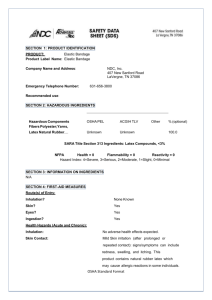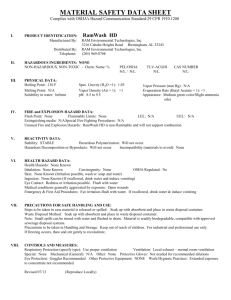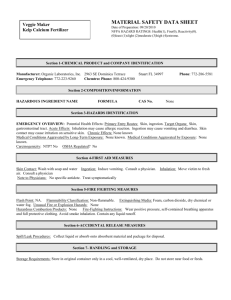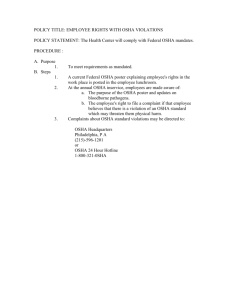Sample Lesson Plan - USF OSHA Training Institute Education Center
advertisement
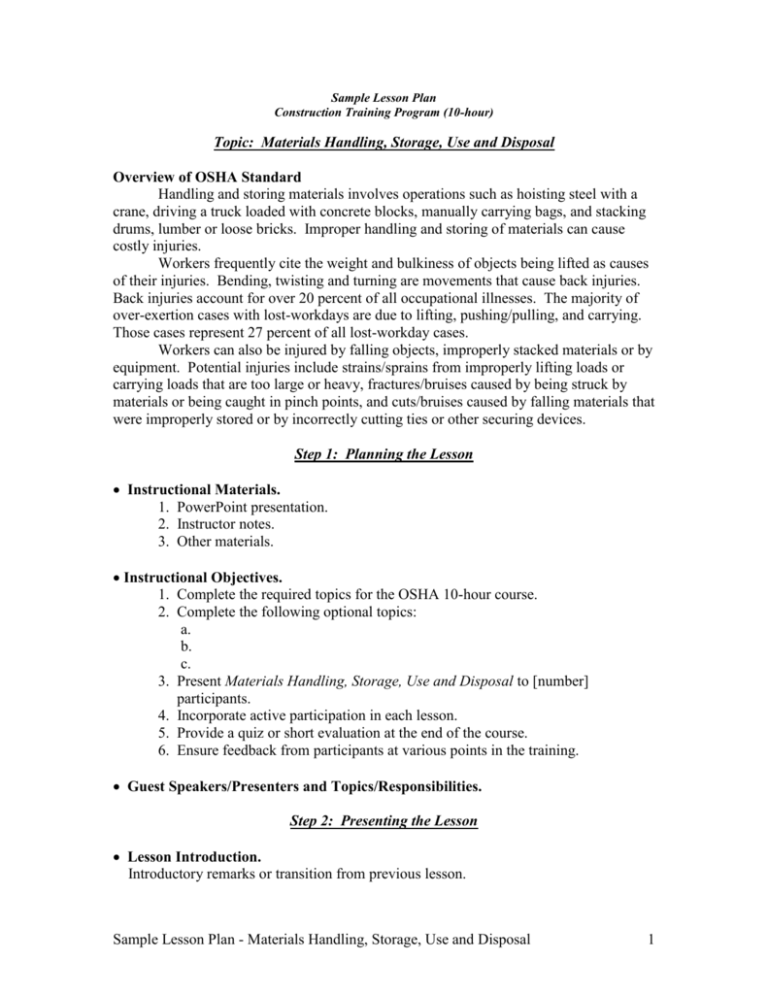
Sample Lesson Plan Construction Training Program (10-hour) Topic: Materials Handling, Storage, Use and Disposal Overview of OSHA Standard Handling and storing materials involves operations such as hoisting steel with a crane, driving a truck loaded with concrete blocks, manually carrying bags, and stacking drums, lumber or loose bricks. Improper handling and storing of materials can cause costly injuries. Workers frequently cite the weight and bulkiness of objects being lifted as causes of their injuries. Bending, twisting and turning are movements that cause back injuries. Back injuries account for over 20 percent of all occupational illnesses. The majority of over-exertion cases with lost-workdays are due to lifting, pushing/pulling, and carrying. Those cases represent 27 percent of all lost-workday cases. Workers can also be injured by falling objects, improperly stacked materials or by equipment. Potential injuries include strains/sprains from improperly lifting loads or carrying loads that are too large or heavy, fractures/bruises caused by being struck by materials or being caught in pinch points, and cuts/bruises caused by falling materials that were improperly stored or by incorrectly cutting ties or other securing devices. Step 1: Planning the Lesson Instructional Materials. 1. PowerPoint presentation. 2. Instructor notes. 3. Other materials. Instructional Objectives. 1. Complete the required topics for the OSHA 10-hour course. 2. Complete the following optional topics: a. b. c. 3. Present Materials Handling, Storage, Use and Disposal to [number] participants. 4. Incorporate active participation in each lesson. 5. Provide a quiz or short evaluation at the end of the course. 6. Ensure feedback from participants at various points in the training. Guest Speakers/Presenters and Topics/Responsibilities. Step 2: Presenting the Lesson Lesson Introduction. Introductory remarks or transition from previous lesson. Sample Lesson Plan - Materials Handling, Storage, Use and Disposal 1 Learning Objectives/Outcomes. Upon completion of the lesson, participants will be able to: 1. List the three main injuries that occur during material handling, storage, use and disposal. Possible responses. Back injury Struck by Crushed by 2. Describe at least 2 ways to prevent injury when performing manual lifting. Possible responses. Lift with your legs, keep your back straight and do not twist Get help when moving large or bulky items Use handling aids Break load into parts that are of a more manageable size and weight Avoid lifting above shoulder level Use gloves and safety shoes 3. Explain at least three ways to eliminate hazards that may lead to injury when using forklifts, cranes or slings to handle materials. Possible responses. Forklift Train employees in proper use and operation Center the load on the forks and close to the mast Avoid overloading Place load in lowest position for traveling Keep arms and legs inside truck No riders Don’t drive with raised forks Crane Train employees in proper use and operation Check load chart in the cab and abide by load limits Inspect frequently Never lift people Avoid overhead power lines Insure area of travel is clear Have competent person inspect, as required Sample Lesson Plan - Materials Handling, Storage, Use and Disposal 2 Learning Objectives/Outcomes. (Continue) 3. Responses for objective 3 continued. Sling Inspect slings each day before use and where service conditions warrant Ensure hooks, rings or other attachments have a rated capacity at least equal to the chain to which they are attached Don’t use job or shop hooks or makeshift fasteners Lubricate ropes and chains Remove worn equipment from service, if damaged or defective 4. Describe at least three actions that can reduce or eliminate hazards when storing, using or disposing of materials. Possible responses: Secure material stored in tiers by stacking, racking, blocking or interlocking to prevent from falling Post safe load limits for floors Keep aisles and passageways clear Don’t store materials within 6 feet of a hoistway or floor opening Wear fall protection when working on stored materials in silos, hoppers or tanks Don’t stack bricks more than 7 feet high and taper a loose brick stack after it is 4 feet high Remove nails before stacking lumber Stack lumber so it is stable and self-supporting Keep storage areas clear of accumulated materials that cause tripping, fires or explosions, or may contribute to harboring rats or pests Do not store potentially hazardous materials or incompatible materials; ensure they are properly disposed of Planned Activities, Discussion, or Participant Interaction Step 3: Evaluating Student Learning and Instruction Lesson Evaluation and Comments. . Sample Lesson Plan - Materials Handling, Storage, Use and Disposal 3 References OSHA Standard: 29 CFR 1926 Subpart H (1926.250 to 1926.252) OSHA Publications http://www.osha-slc.gov/OshDoc/Additional.html 2236 Materials Handling and Storing 3072 Sling Safety 3170 Safeguarding Equipment and Protecting Workers from Amputations OSHA References/Resources Construction Safety and Health Outreach Program - Materials Handling and Storage http://www.osha.gov/doc/outreachtraining/htmlfiles/mathan.html Construction Safety and Health Outreach Program - Sling Safety http://www.osha.gov/doc/outreachtraining/htmlfiles/slings.html OSHA Construction eCAT - Struck-by: Vehicles http://www.osha-slc.gov/SLTC/construction_ecat/struckby/vehicles.html OSHA Technical Manual - Back Disorders and Injuries http://www.osha.gov/dts/osta/otm/otm_vii/otm_vii_1.html OSHA Technical Manual - Forklifts, Powered Industrial Trucks http://www.osha.gov/SLTC/poweredindustrialtrucks/index.html Sample Lesson Plan - Materials Handling, Storage, Use and Disposal 4


